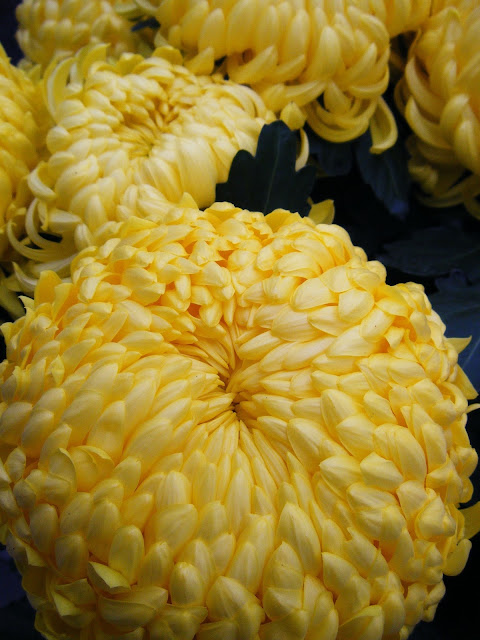Back in October, I took some photos of the beautiful Chrysanthemum blooms that are used to decorate the graves all over France for the Toussaint (All Saints’ Day) on the 1st of November. Needless to say, I never found any time to do anything with the flower photos at that particular time, but they implanted a little creative seed in my mind with an intention to make my own Chrysanthemum designs. While I’m not sure if I’m totally satisfied with the first results of my germinating creation, to be seen further down the page, at least I’ve managed to do something with my flower pictures on this post, if nothing else!
With their magnificent round, petalled heads resembling a bird’s plumage, the flowers seem to draw you in, make you cup their feathered form in your hands (much to the florists’ disapproval!) to wonder at their perfection. Just looking at the photos makes me want to touch the curved waxen petals, and hold the bird-like mass again. I’ll just have to wait till November for that privilege, I suppose…
Over twenty million pots of chrysanthemums are sold In France over the late autumn/Toussaint period, representing a significant share of the annual floral market. Indeed this plant is to All Saint’s Day what the Lily of the Valley is to the 1st of May in French tradition. Sadly, though hardly surprising, for many French people the beautiful chrysanthemum seems to bear rather morose, if not morbid, associations. Not being French, I can only see these flowers (that are indeed to be seen everywhere at the Toussaint) as majestic and slightly surreal in their beauty.
The florets that compose these voluminous heads seem to defy any natural floral form, in fact they simply do not appear to be made out of vegetal matter at all, but of some strange composite material. Synthetic petals curve upwards or downwards, in feathery formation in rich colours of cream, gold, delicate pink or dazzling white. The ‘flowers’ are actually inflorescences, composed of hundreds of florets in ray or disk layout. The heads assume many forms – governed by the overall shape, curve and form of the florets and so on… Incurve, Reflex, Pompon, Anemone, Spoon, Quill, Spider and Brush being just a few of the names given to specific exotic formations. The plant itself is fairly resilient in harsher weather, and indeed comes into bloom when the summer days have truly died out (allegedly never before the autumn equinox), and the flowers unfurl themselves, like birds disturbed in their nest, to their fully-fledged beauty, ready for La Toussaint, this resilience being a symbol of immortality itself.
Although now fully anchored in French commemorative moeurs, the flower has ancient roots and distant origins. The chrysanthemum genus from the Asteraceae family finds its origin in the Greek words chrysos –signifying gold – and anthos – flower –also associated with its Chinese name, mums.
Initially grown as a flowering herb with medicinal and restorative properties in China the chrysanthemum was mentioned in the writings of Confucius. In the 15th century the flower was referred to as one of the ‘Four Gentlemen of China’ (along with plum blossom, the orchid and bamboo). The flowers of certain species of the family are still used to make a form of tea drink, others to provide distinctive flavouring to meals, others again may function as insecticides. When the plant was taken to Japan in the 8th century A.D. the emperor took the chrysanthemum flower as his official seal; the Chrysanthemum Throne being the term used to indicate the emperor’s position.

While the Asteraceae family encompasses many species of flower –all vaguely related to the daisy with its star-like formation (cf Greek=aster) – the variety in shape and form is vast. Some members of this ‘daisy’ family assume an appearance that seems to belie their origins and yet they share many characteristics – the sunflower, Echinacea, arnica, artichoke, endive and lettuce being but a few examples. Like the ‘true’ daisy, Day’s Eye (bellis perennis), the rather more exotic chrysanthemum bears a light-sensitive clock system which enables it to bloom at the appropriate time of year when the days are at their shortest.
Another well-known member of the Asteraceae family, that I have frequently taken to be the chrysanthemum is, of course, the Dahlia.
With flowers that assume varied forms and widely diverse petal formation often similar to those of the chrysanthemum, this mistake is easily made. The dahlia has eight genes that determine its appearance, unlike more ‘ordinary’ flowers that bear just two genes. This means that the dahlia proves to have great versatility, leading to huge variation in form, colour and size. In fact, not only do the two flowers bloom at very different periods of the year, but they originate in very different parts of the world.
 |
| Rather sausage-like petals, but getting there... |
 |
| First attempt - a bit chunky and clunky... |
 |
| Yuck! Third-time unlucky, but I won't be deterred in my dahlia mission! |
I’ll post the outcome….








